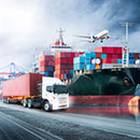
Cargo owners are seeking alternative transport modes such as sea-air and intermodal rail freight for shipments from China, to avoid production and supply chain delays, aas high demand for personal protective equipment and recovery of production in China meets growing air freight capacity constraints, forwarders report.
Despite an accelerating drop in overall global tonnages carried by air at the end of last month, international air freight forwarders continue to report tight capacity on many key lanes – notably ex-Asia and also the transatlantic.
With the drop in both air freight capacity and tonnages at the end of last month, global forwarding and logistics giant Kuehne + Nagel (KN) noted that with the majority of carriers closing down or making large cuts in their passenger networks, it was seeing acute shortages of lift on many trade lanes, particularly ex-China. In order to compensate for the belly cargo capacity shortages, freighter capacity had significantly increased, although this increase was not sufficient to offset the strong drop in global belly capacity.
Yngve Ruud, executive vice president for air logistics at KN told Lloyd’s Loading List: “We see tight capacity on all lanes from China due to production and high demand for personal protective equipment flows and increasing capacity constraints from South America into Europe. Transatlantic is heavily affected due to severe cuts of PAX flights, which gives additional constraints.
“The picture is quite complex. We believe there is a mix of various drivers: a drastic reduction in a commercial capacity – with close to 50% of all planes globally ground as of today – partly mitigated by an increase of freighter capacity of approximately 20%, in combination with general demand reduction on traditional commodities, such as perishables and other industry sectors. And, additionally, we have seen a change in supply chain and demand forecasting.
“The capacity constraints are related to the main trade lanes where freighters are operating, and the shift in the supply chain on these trunk lanes is caused by reductions of capacity from and to secondary airports. On top of that, there is a huge demand from Governments on Mask and Personal Protective Equipment, which are mainly charter/full freighter related.”
Ruud continued: “The drop in air freight market demand is significant, but still at the moment doesn’t balance out the challenges coming from capacity constraints on all trade lanes.”
KN stressed that its air freight branches were all fully operational and were providing “a range of flexible solutions in these volatile times”, including sea-air, time-critical and charter services, which were reporting significant interest or requests from clients to use slower alternatives such as sea-air and overland because of the air capacity constraints and consequent price rises.
“Due to the capacity constraints and recovery of production in China, the number of customer requests for sea-air has seen a substantial increase, as customers are looking for alternative ways to avoid production and supply chain delays,” the company confirmed.
Other freight forwarders, including the UK’s Davies Turner and Austria’s Cargo-partner, have reported strong demand for China-Europe rail freight services – which have now resumed following the lifting of most restrictions in China – in response to the current capacity restrictions.
Source:lloydsloadinglist
The opinions expressed herein are the author's and not necessarily those of The OLO News.
Quality Companies